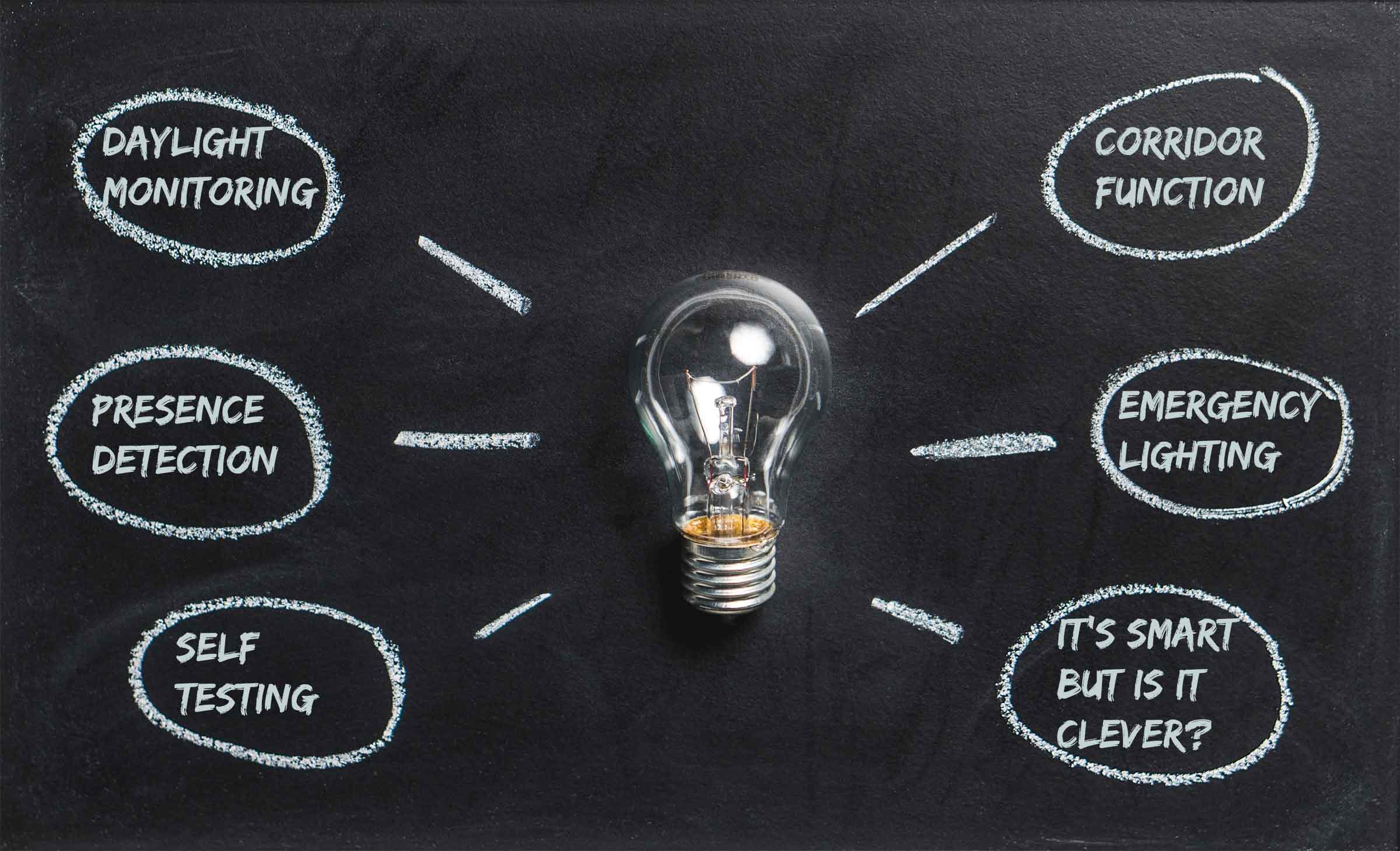Coughtrie started manufacturing innovative lighting solutions in 1940. Since then the lighting industry has changed beyond recognition. Coughtrie has remained at the forefront of technology, with the recent focus to drive down energy costs and CO2 emissions of individual luminaires. This trend has moved the industry focus from incandescent to fluorescent to LEDs and the dawn of interaction via the Internet of Things is here. Now that we are moving on from a simple manual on/off switch, what is the right level of ‘intelligence’ needed in our luminaires?
There are many levels of intelligence in lighting from a basic household dimming switch to the latest autonomous building or district management systems. A household dimming switch allows the user to judge by eye what light level is needed. In contrast, a completely automatic control system can ensure all lights are off, unless the area is in use, greatly reducing energy, CO2 footprint and maintenance costs, while maintaining emergency response, safeguarding property and persons. But what do you need?
Daylight Monitors
Daylight is free and depending on time of day or weather, readily available. Additionally, daylight is our primary source of vitamin D with deficiency resulting in health issues such as bone softening, density loss, cancers, seasonal and other depressions. Furthermore, the benefits to productivity from natural light are a source of study for environmental scientists.
So, it makes good sense from both health and business perspectives to ensure that daylight is used and technology can help. Whether internal or external, photocells measure the ambient light falling on them and can respond either with an on/off, when a threshold is reached, or adjust artificial illumination to match a pre-set target level.
The method of dimming (switching, magnetic choke, dimmable ballasts) will be determined by the type of luminaire being used but there are important points to consider:
What is the response time to light level changes and is it smooth? This avoids noticeable darkening and flaring of illumination.
Are the controls external for the entire building i.e. one per aspect or interior and per room or workspace area?
What is the quality of the light? The colour and quality of solar illumination changes by season, time of day and cloud cover. To prevent glare and contrast issues, daylight monitoring needs to be integrated with external light control. In a simple form this can be an opal diffusion skylight or more elegant automatic blind controls.
So daylight monitoring will reduce costs and CO2 emissions compared to ‘always-on’ lighting. Additionally by integrating with natural sunlight there is the chance to improve employee health and productivity. However, this solution is only optimal if every workspace is utilised seven days per week. There are also the costs to consider including the fitting of additional sensors and potentially, additional cabling. These costs need to be weighed versus the potential saving and alternative solutions.
Presence Detection
The next big step is only having illumination when an area is in use, indoors or outside, and can be anywhere from a work station to a loading bay to a stairwell. Another consideration is whether ‘hands-free’ activation is required, which can be relevant for loading bays and work stations.
Passive infra-red (PIR) sensors detect body heat and movement. PIR is ideal for smaller areas, especially with a uniform background temperature, and larger movements. Have you ever played the game with PIR alarm sensors, where you try to cross a room without the detection light coming on? This illustrates a limitation with PIR, if you are stationary either sat at a desk or similar, the lights can suddenly cut out, necessitating arm waving to bring them back on.
While a PIR can be calibrated for sensitivity, one thing we know in the UK is that our temperatures vary. The last thing we need when permanently installing a system to save energy, is false switch-ons caused by distant warm objects on a cold days or failure to switch on in the event of warmer weather. Is there a better system?
If passive infra-red works on long-wavelength light, below the perception of our human eyes, microwave detection is towards the other end of the electromagnetic spectrum, with short-wavelength radio waves in the 1 to 300mm range. Both ‘light’ and ‘radio waves’ are electromagnetic radiation but their wavelengths and frequencies differ, hence their properties and energy are also different. Microwaves are more familiar as a kitchen accessory but they are based on radar, the quintessential detection technology, developed in World War 2.
Microwave presence detectors use a very low power system (unlike radar and microwave ovens!), but are ideal for reacting to smaller or more distant movement. Microwave presence detection utilises the Doppler Effect to identify even small movements but is not entirely without drawback. Microwaves are effectively blocked by metal but can detect movement through lighter building materials and even glass.
Corridor Function
‘Corridor function’ is the next stage in presence detection, ideal for reducing the running costs of places were illumination is required, especially by law, all day. The applications are as varied as entrances, halls, carparks and cashpoints but also highly specialised environments from underground railway stations to hospitals.
Built into the control gear of modern luminaires is the facility to switch on and follow users as they interact with an environment. Typically dimmed to a dusk light level (10%), when the luminaire microwave detector registers a presence it rapidly increases output to 100% or other predetermined level. The lighting then dims back to base level after a predetermined period without detecting presences.
This ingenious and simple system ensures that lighting is supplied only when required and effortlessly for the user. The parameters from light output to detection threshold and switch-off after detection are entirely customisable for a given scenario.
Emergency Lighting
Emergency lighting is a legal requirement in all public buildings and working environments. Emergency lighting is designed to facilitate the safe and rapid exit from a building in the event of mains power supply failure. Interruptions in mains power are mercifully rare so the causes are often serious and the most common emergency trigger is a fire alarm.
Fire escape routes and doors in the UK are required to be illuminated to at least one lux. For the uninitiated, this is somewhere between dusk and full-moon light levels. Additionally, this illumination must be maintained for at least one to three hours through either an uninterruptable power supply or, more commonly, batteries integral to individual luminaires.
Emergency lights are easily identified as having a green LED which indicates correct operation and that the battery-pack is charged.
Emergency lights can either be dual purpose, standard luminaires that double as emergency lights or be ‘emergency only’ that switch on in the vent of power failure.
Fire Precautions (Workplace) Regulations 1997 & BS5266 part 1 requires emergency lighting systems to be regularly tested and maintained in proper working order. While light failures are unlikely, the cost for testing can be high even if the electricians only charge for their time. At three plus hours minimum to check discharge per set or location, that can rapidly increase the cost to many hundreds of pounds for a large building.
Self-Testing
Modern lighting systems can include a self-test function that carries out routine tests of function and duration, while eliminating the need for manual testing. An automated report of faults ensures compliance, if they are actioned, making self-test a highly cost effective option… If it is configurable.
Imagine a corridor or workspace without external illumination and the self-test starts. Light levels suddenly drop to 10% and stay there for three-hours. Tripping hazards and inconvenience for users would be the least of these concerns!
Choosing a modern, high efficiency luminaire with self-test is one thing but ask the next question, can the self-test frequency and timing be controlled?
Is It Smart?
Modern lighting whether it is LED, fluorescent or older technology can be as smart as your application needs.
You can combine daylight detection, presence detection, corridor function, emergency lighting and even self-testing and many companies will sell you all of that, for a hefty price. What you need is expert advice and the right solution for your application.
The modern luminaire has the answer to your lighting needs without even needing to flick the switch but where do you stop? What level of technology is going to deliver the solution that your need for now and the foreseeable future?
Is It Clever?
The bulk of a building’s cost is in the variable operating charges after construction and before demolition. Energy efficiency reports are a standard part of the sale or lease of buildings and being able to deliver a cost effective solution, which will last as long as a building, is a good investment.
Since 1940 Coughtrie has been a name to trust in the British lighting industry. Always at the cutting edge of technology, Coughtrie manufactures luminaries that are as intelligent and efficient as you need. From the British manufacturing plant all luminaires are delivered with the assurance of 100% testing ready to be installed and when Coughtrie units are installed, they last. For over 80 years, Coughtrie luminaires have been tried and tested from anti-ligature to vandal-resistant to 1,000 hour+ salt spray testing, so when we say ‘built to last’, trust us!

